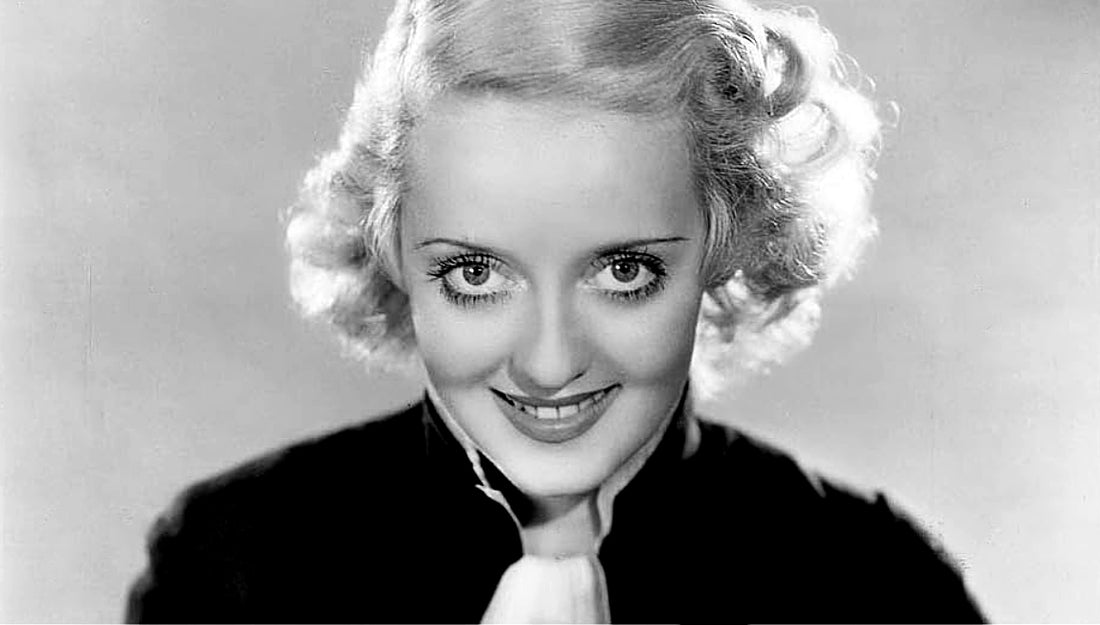Pandora Writer |
____________________

Ruth Elizabeth Davis, known to the world as Bette Davis, was born on April 5, 1908, in Lowell, Massachusetts to Ruth Augusta Davis (Favor) and Harlow Morrell Davis. Bette faced family changes early in life. At the age of seven, her parents' divorce left her mother responsible for raising Bette and her younger sister Barbara alone.
During her teenage years, Davis delved into acting through school productions at the Cushing Academy in Massachusetts. After gaining experience in summer stock theater in Rochester, New York, she relocated to New York City. There, she enrolled at the John Murray Anderson/Robert Milton School of Theatre and Dance, where Lucille Ball was among her fellow classmates.
Bette's foray into Hollywood was not an overnight success. After a brief stint in Broadway productions, she made her film debut in the low-budget drama "Bad Sister" in 1931. It wasn't until her role in "Of Human Bondage" in 1934 that critics and audiences took notice. She portrayed the ambitious and ruthless character of Mildred Rogers in the film adaptation of W. Somerset Maugham's novel "Of Human Bondage."

The turning point in Davis' career came with the film "Dangerous" in 1935, where she played a troubled young actress, for which she won her first Academy Award for Best Actress. This marked the beginning of her rise to stardom. She was known for her distinctive voice, intense gaze, and ability to convey complex emotions.
Throughout the late 1930s and 1940s, Davis delivered one memorable performance after another. Films like "Dark Victory" in 1939, and "The Letter" in 1940 highlighted her versatility. Despite facing resistance from studio executives who often typecast her, Davis continued to push boundaries.
Bette Davis was not just an actress; she was a Hollywood rebel who defied the system and fought for creative control. In the early 1940s, Davis faced a contractual dispute with Warner Bros. and took legal action to secure better roles and compensation. This bold move resulted in her departure from the studio, making her one of the first actors to successfully challenge the studio system's restrictive contracts.

In 1942, Davis delivered a mesmerizing performance in "Now, Voyager," earning her another Academy Award nomination. This film, along with her Oscar-winning role in "Jezebel" in 1938, solidified Davis's reputation as one of Hollywood's greatest leading ladies.
As the 1950s dawned, Davis faced a decline in her career, with several box office disappointments and critical failures. However, she experienced a remarkable resurgence with her role in "All About Eve" in 1950. Playing the role of Margo Channing, an aging actress facing the challenges of a younger rival, Davis delivered a tour de force performance that earned her another Academy Award nomination. This film not only revitalized her career but also became a classic in cinematic history.
While she continued to receive acclaim for her performances in films like "The Star" in 1952 and "Whatever Happened to Baby Jane?" in 1962, she also faced challenges from a changing Hollywood landscape that favored younger actresses. Undeterred, Davis adapted to the times, transitioning to television and theater while maintaining her commitment to delivering compelling performances.

Joan Crawford and Davis had a longstanding feud, and tensions persisted during the production of the horror film "What Ever Happened to Baby Jane?" Davis played a former child star caring for her disabled sister. In response to Joan Crawford's association with Pepsi (as the widow of Pepsi's CEO), Bette Davis had a Coca-Cola machine installed on the set. Joan retaliated by adding weights to her pockets during scenes where Davis had to drag her across the floor.
"There's only one way to work -- like hell.”
― Bette Davis
Davis portrayed twin sisters in dual roles in two films: "A Stolen Life" in 1946 and "Dead Ringer" in 1963.

In the latter part of her career, Davis remained a force to be reckoned with. Despite health issues, she continued to work tirelessly, earning critical acclaim for her roles in films like "Hush...Hush, Sweet Charlotte" in 1964 and "The Nanny" in 1965. In 1977 she received the American Film Institute Life Achievement Award.
Davis filmed a television pilot for a series titled "The Bette Davis Show" in 1965. Unfortunately, it was not selected for series by any television networks. However, it aired as a television movie under the title "The Decorator."

Davis made history as the inaugural actor to garner ten Academy Award nominations. She was honored with two stars on the Hollywood Walk of Fame, one for Motion Pictures at 6225 Hollywood Blvd. and the other for Television at 6335 Hollywood Blvd.
Behind the glamour and success, Bette Davis faced her fair share of personal challenges. She was married four times. Davis also struggled with health issues throughout her life, including a battle with breast cancer. She continued to smoke cigarettes daily, persisting in this habit even after experiencing four strokes.
In 1983, she received the Distinguished Civilian Service Medal, the highest civilian honor from the Defense Department, in recognition of her role in establishing and operating the Hollywood Canteen during World War II.
There is a song called "Bette Davis Eyes," performed by Kim Carnes. The song was released in 1981 and was a major hit. The song's lyrics metaphorically describe a woman with captivating and alluring qualities, comparing her to the legendary actress Bette Davis.

In an era when Hollywood was dominated by male executives and controlled by studio contracts, Bette Davis stood as a symbol of empowerment. She rose to prominence as one of the biggest stars in Hollywood, appearing in nearly 100 films until her passing.
Bette Davis passed away on October 6, 1989, at the age of 81. The cause of her death was breast cancer. She is interred at Forest Lawn Memorial Park in Hollywood Hills, Los Angeles, California. Her final resting place is in the Freedom Mausoleum.
“The only way you can become a legend is in your coffin.”
― Bette Davis

